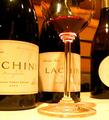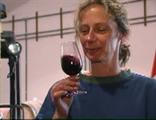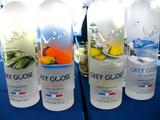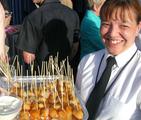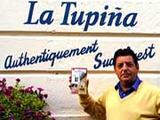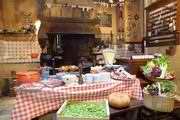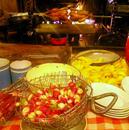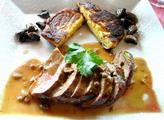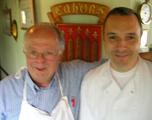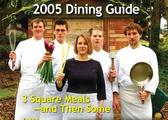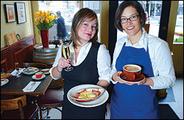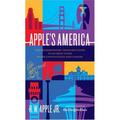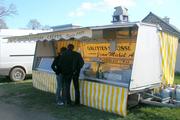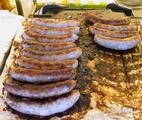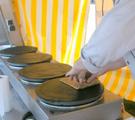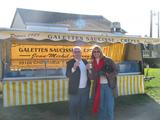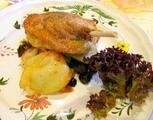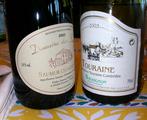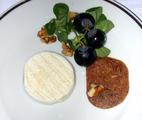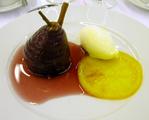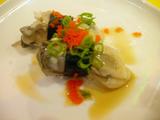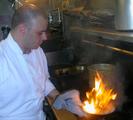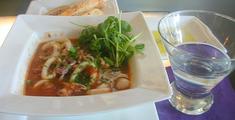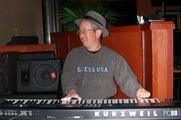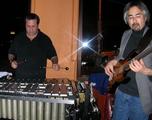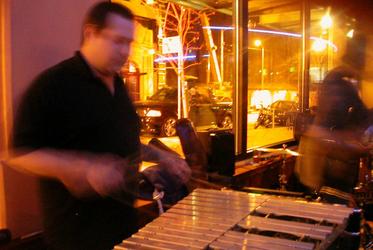April 30, 2005
French Connections
More links between Oregon and France: the winemaker for Lachini Vineyards in Dayton, Ore., Isabelle Dutartre, actually lives in the Languedoc.
Lachini just released its third vintage, which I tasted last week. Familiar story: Ron Lachini left California and a career in the pharmaceutical industry seven years ago to grow pinot noir in Oregon. He has a new day job now with Morgan Stanley and employs two winemakers, each responsible for a separate cuvée: local lad Peter Rosback and Isabelle, who visits several times a year.
Peter's wine is very "American," a self-consciously crafted bottle, picked late, with lots of new oak. Isabelle's, on the other hand, is very "Burgundian," lighter, more restrained, elegant.
Isabelle is a longtime friend and colleague of Véronique Drouhin, daughter of a leading Burgundian family and winemaker for its pioneering venture, Domaine Drouhin Oregon. After five vintages at DDO Isabelle returned to France to raise a family, signed on as a consultant to a Burgundian barrel manufacturer, and now regularly flies over to drop on her Oregon clients.
April 29, 2005
Swank party
UPDATE: June 9th story in Seattle Times finally acknowledges 2200 Westlake's success! Better late than never.
Gala opening a couple of nights ago for 2200 Westlake's new Sales Center, kiddy corner from the construction site at Westlake & Denny. Seventeen months from now, 2200 will have three towers, including a 160-room Pan Pacific Hotel, a Whole Foods store and 261 condo units priced from $300K to about $2 mill. (Better hurry, 160 units are already spoken for.) Project developer Don Milliken calls it "the gold standard for urban living."
The open bar featured Grey Goose martinis and a variety of hors d'oeuvres catered by Ray's Boathouse, whose estimable executive chef Charles Ramseyer, kept a personal eye on the proceedings.
Did the daily papers show up? Hell, no. What they reported instead was that all the South Lake Union development is going to require that Seattle City Light build a new substation. Huh?
April 27, 2005
50 Best Restaurants
Latest issue of the British magazine Restaurant has a list of the 50 "best" restaurants.
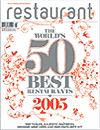
Named tops in the world was the Fat Duck in Bray, an hour outside of London. Best American is Thomas Keller's French Laundry in Yountville, Calif. Most of the places have already been adorned with a galaxy of Michelin stars.
Sneaking in at number 50, however, is a simple, straightforward place in Bordeaux, La Tupina, devoted to authentic ingredients from the southwest of France. Congratulations to owner Jean-Pierre Xiradakis, who often welcomes his guests in front of the restaurant's great hearth.
April 26, 2005
Just Ducky
Cahors: medieval city on the Lot River in southwestern France. Fortified bridge, the Pont Valentré.
Lunch in a floating restaurant, Au Fil des Douceurs. The celebrated Philippe Larguille is the chef, assisted by his dad. Mom's the waitress. On the menu, this being southwestern France: duck. Delicious local wines from the Côteaux du Quercy. Wouldn't this be a great spot to spend a few days of wine-tasting?
April 25, 2005
Wiggly Food Photos
Best part of Seattle Weekly's latest guide to eating out are the photos by Pete Kuhns. A sometime sports photog who spent time at sister-paper Village Voice, Kuhns seems to have found his element shooting teams who toil in tiny kitchens.
Not unexpectedly, archrival The Stranger comes up with a food guide of its own, devoted to Street Eats. A topic worthy of serious study, as readers of Calvin Trillin can attest. Sadly, the Street Eats pullout guide suffers from The Stranger's anti-intellectual affectations; even the paper's sexiest food writer, Bethany Jean Clement, is reduced to writing about a self-loathing hot dog vendor.
Faithful readers may recall the 2004 catfight when The Stranger's cover was a takeoff on Seattle Weekly's dining guide. This year, thanks in part to the terrific photos, I say Weekly wins.
April 24, 2005
Apple a Day
Johnny Apple, the portly gastronome who doubles as a globetrotting New York Times political reporter, is in Seattle this weekend on a nationwide book tour. His latest, Apple's America, profiles 40 cities: 5 or 6 pages of civic history, a map, and 2 or 3 pages of where to stay and where to eat.
On the longterm health of journalism: "We spend too much time playing gotcha, not enough explaining the complexities of the world." Advice to aspiring reporters: study economics.
Advice for Seattle dining? Apple recommends Canlis, Dahlia Lounge, Mistral, Le Pichet, Ray's, Shiro's and Wild Ginger.
He had dinner last night at Lampreia, watched his own profile on CBS Sunday Morning, had lunch at Le Pichet ["makes me feel like I'm in Paris"] and plans dinner tonight with seafood guru Jon Rowley at Union. Tomorrow he heads to Walla Walla, where he hopes to round up a bottle or two of Leonetti Cellar. What a life!
June 12, 2005 UPDATE: Here's the link to a review of the book in today's New York Times Book Review.
April 23, 2005
The Gallant Gallic Galette
Buckwheat flour, darker and tastier than refined white flour, is the perfect base for pancakes. In the Brittany region of France, it's the basis for both sweet crèpes and savory galettes.
In fact, a country sausage wrapped in a galette is kind of like a ballpark frank, in the same way that a BMW is kind of like a Buick.
This fellow had pitched his wagon near a popular spot on the 50-mile-long waterway, the Canal Ille et Rance that runs north-south across Brittany, at a place called Hédé, where a series of 11 locks climbs the hillside from the Atlantic Ocean towards the English Channel.
April 21, 2005
Lunchtime!
I’ve just spent ten days in France, attending a series of trade shows for people in the travel industry. Here’s the thing: there’s no fancy new equipment to look at, no lavish exhibits, just a warren of booths staffed by folks from hotels, local tourist boards, bus companies. You have a schedule: an appointment every 20 minutes. But at 1 PM on the dot, everything comes to a halt and everyone—300 exhibitors, 300 delegates—files into the convention center’s “restaurant.” What’s going on?
Well, duh, this is France, and it’s lunchtime. Three courses, three sets of cutlery, glasses for wine and water, plus a cup for the post-prandial coffee, cloth napkins. Anything less would be a scandal.
The first course is already plated: a fillet of smoked trout, perhaps, with walnut salad, or freshly cured salmon with field greens. White wine, naturally. The red wine goes with the second course: a duck confit, perhaps, or a chicken breast wrapped in cabbage and pastry dough. The waiters move quickly; they’re used to the pace. Dessert and coffee: a sorbet with plum brandy, or a caramelized apple tart.
In the afternoon session, some exhibitors offer visitors a glass of champagne "to tide you over." The gala dinners (three of them on this trip) begin late, eight-ish, always with an aperitif followed by at least two wines and a digestif. Four or five more courses (a fish appetizer, a main course, cheese, dessert). Music, interminable speeches badly translated into English, more music. The formal banquet: it’s like church, a familiar rite for the French, who seem to take comfort in its ritual. Midnight and counting, with an early start the next morning, only the Americans, disoriented and tipsy, get impatient and annoyed.
April 19, 2005
Pyramid Schemes
UPDATES: Four alternative designs to the food pyramid in Slate ...
... and check out Mark Fiore's "It all started with the Pyramid" cartoon ... hilarious!
Agriculture Department releases new food pyramid with "vertical stripes." Not one-size-fits-all, either. No less than 12 styles. Can't wait to hear the howls of derision.
Two more disturbing items. First, a report from the Centers for Disease Control saying that it's OK to be a little bit overweight.
And second: those studies showing that moderate drinking helps you live longer may be flawed. Argument is that the moderate drinkers had healthier lifestyles in the first place. But isn't that precisely the point?
To me, it looks like the puritan food lobby got into the henhouse again.
April 18, 2005
Mellow Monday
Much wailing at the growing number of sushi bars in Belltown. Tell me again, why is this a bad thing?
Latest is Wild Fish, which has moved into Afrikando's space at 1st & Broad. No liquor license yet, but owner Kyeong Han is doing fine with a four-item "sushi set" of tuna, salmon, albacore and shrimp for $4 during the Mon-Sat happy hour. Even better, not on the menu, oyster sushi. Instead of being served on the half-shell, the oyster is plopped on a pillow of rice, wrapped in nori, anointed with plum sauce and topped with tobiko. It's wonderful.
Not far away, The Apartment is running its happy hour all day long on Mondays. The cucumber-infused martini is $4, and chef Colin Regis will fire up an order of calamari, $5, sauteed with garlic, sambal oelek and flavored with a bit more of the cucumber vodka.
April 1, 2005
The vibe at Alexandria's
Come to Alexandria's on Tuesday or Thursday night to hear some of the best jazz in Seattle. Without any fanfare, it's the legendary Deems Tsutakawa and his gang.
Not often you see so many Asian musicians in one group: Deems, wearing a funky hat, is on keyboard, David Yamasaki on guitar, Marcus Tsutakawa on bass ... All the more reason to mention Kevin Boyd, who's Caucasian, on vibraphone. Without showboating, he quietly dazzles the room with his technique.
